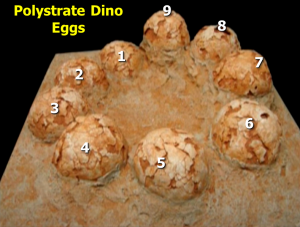Blog: Trace Fossils & Eggs – Part 4
 Last month we noted that fossilized dinosaur eggs are typically found on a flat bedding plane, like a muddy beach. This fits well with a Flood scenario in which female dinosaurs laid eggs under duress as thick sediment layers were rapidly accumulating around them. But we also have some special cases in which these these dinosaur nests are “polystrate” fossils, that is they go through multiple sedimentary rock layers. Paleontologists have observed this at a site in Lleida, Spain, where a number of fossilized Titanosaur eggs were found at various levels. These layers might have been interpreted as millions of years apart. But it is obvious the eggs were all laid at in the same timeframe. So, the layers must have been forming very rapidly. In some cases the layers were forming while the mother dinosaur was actually laying her eggs! Notice the fossil nest to the upper right. This nest, found in Mongolia, shows how the dinosaur swiveled around and laid her eggs one after the other even as the muddy waters swirled around her. Egg number one is buried deep in the mud while number 9 is atop the sediment layer! By the time she finished laying, inches of additional mud had built up. Or perhaps exposed sediment had dewatered so the egg no longer sank into it. These fossilized dinosaur eggs are clear evidence of catastrophic global conditions at the time when the dinosaur fossils were being formed.
Last month we noted that fossilized dinosaur eggs are typically found on a flat bedding plane, like a muddy beach. This fits well with a Flood scenario in which female dinosaurs laid eggs under duress as thick sediment layers were rapidly accumulating around them. But we also have some special cases in which these these dinosaur nests are “polystrate” fossils, that is they go through multiple sedimentary rock layers. Paleontologists have observed this at a site in Lleida, Spain, where a number of fossilized Titanosaur eggs were found at various levels. These layers might have been interpreted as millions of years apart. But it is obvious the eggs were all laid at in the same timeframe. So, the layers must have been forming very rapidly. In some cases the layers were forming while the mother dinosaur was actually laying her eggs! Notice the fossil nest to the upper right. This nest, found in Mongolia, shows how the dinosaur swiveled around and laid her eggs one after the other even as the muddy waters swirled around her. Egg number one is buried deep in the mud while number 9 is atop the sediment layer! By the time she finished laying, inches of additional mud had built up. Or perhaps exposed sediment had dewatered so the egg no longer sank into it. These fossilized dinosaur eggs are clear evidence of catastrophic global conditions at the time when the dinosaur fossils were being formed.
Posted on August 2, 2023 by dwoetzel.
